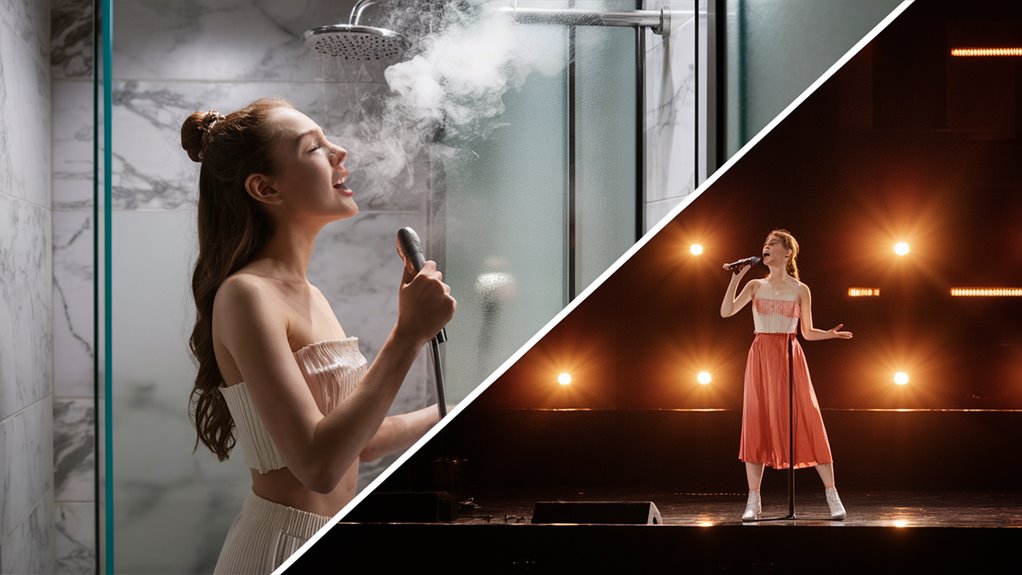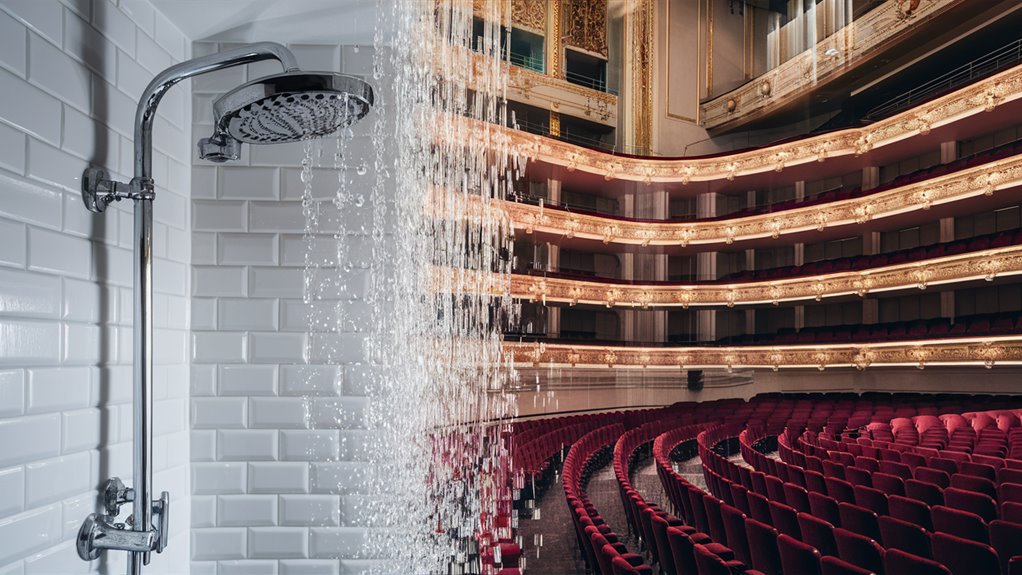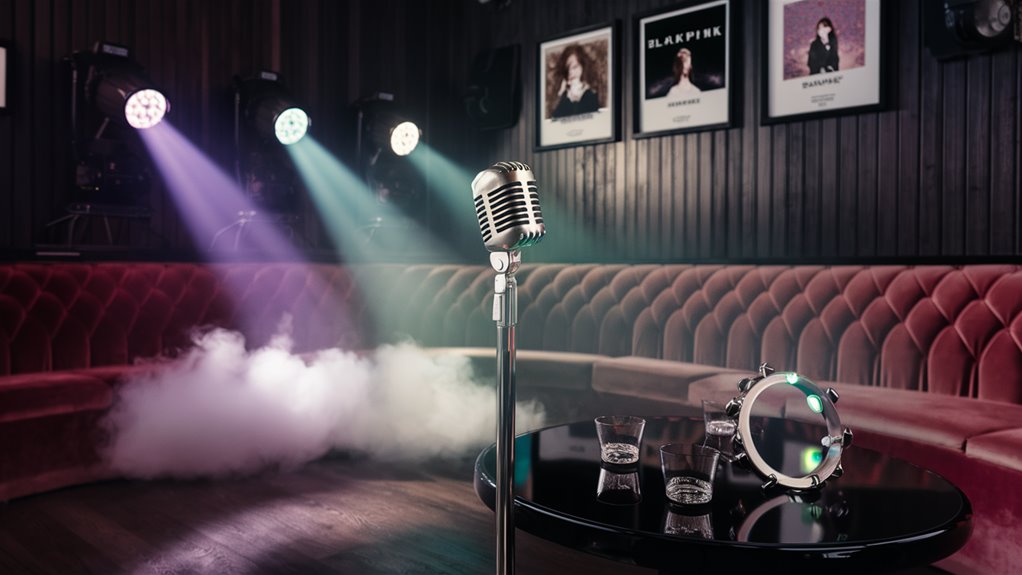Why Your Shower Sounds So Good

The Echo in Your Bathroom
Your bathroom turns into a great sound space through a cool mix of features. Hard surfaces like tile, glass, and porcelain make a great echo space that boosts sound by 10-15 decibels. This boost is like what professional studios have, making your singing in the shower sound much better.
How Water Vapor Helps Your Sound
Water vapor is key in shower acoustics by greatly changing how sound moves. In your shower, sound moves at a fast 1,480 meters per second, rather than the usual 343 m/s in dry air. This speed gives a deeper, richer sound that makes your singing better.
Best Room Size for Sound
A typical bathroom’s size is just right for sound:
- Height: 8-10 feet 호치민 밤문화 팁 더 보기
- Width: 5-7 feet
These sizes work well with human voices, providing just the right sound bounce back.
Top-Level Echo in Your Shower
Your shower gives you concert hall-quality sound through:
- Reverb times of 1.2-2.8 seconds
- Sound waves bouncing off walls 7-10 times
- Many surface reflections before sound fades
These parts come together to make an area that mirrors top music spots, explaining why singing in the shower feels so great.
How Bathrooms Improve Sound
Bathroom acoustics make a unique sound space that makes singing better through certain physical setups.
The mix of hard surfaces and enclosed space creates the perfect echo space that turns regular singing into powerful sound.
How Sound Moves and Hits Surfaces
Sound waves in bathrooms meet many surfaces – ceramic tiles, glass, and porcelain – creating stationary wave patterns.
These moving and returning waves mix, making sounds louder and notes longer. The usual bathroom size (8-10 feet high, 5-7 feet wide) especially boosts sounds in the human voice range (85-255 Hz).
What Changes Sound in Bathrooms
The closed space in bathrooms raises sound pressure levels by 10-15 decibels.
Water vapor from hot showers changes sound by changing air thickness and how sound waves travel. This creates a live room feel, where sound bounces several times before fading, giving a studio-like sound.
Key Sound Parts:
- Parallel surface reflection
- Standing wave setup
- Sound boost
- Long echo time
- Raised sound pressure
- Changed air thickness
These physical parts come together to make the unique better sound that makes bathroom singing so fun.
How Water Changes Sound
Sound Wave Moves in Water
Sound waves go through big changes when they move through water because of its special tiny bits and thickness of 997 kg/m³ at room warmth.
Sound speed reaches amazing speeds of 1,480 meters per second in water, about 4.3 times faster than in air’s 343 meters per second.
The Shower Sound Magic
Water drops make many bouncing surfaces that change sound spread in closed spots.
The vapor-full air raises dampness, right away changing air thickness and how sound moves.
Water vapor tiny bits, being lighter than nitrogen or oxygen bits, let sound move a bit faster, with a 0.1-0.3% speed jump per degree Celsius above room warmth.
How Warmth Changes Sound
Water warmth shows a clear change on sound speed, with each 1°C jump leading to about 3 meters per second speed jump.
This warm link makes different sound changes between hot and cold water spots.
The mix of closed space and water-led changes makes better sound bounce back, creating the special shower sound magic that marks these spots.
Key Parts Changing How Water and Sound Work Together
- Tiny bit thickness changes
- Warmth-based speed shifts
- Damp levels and vapor amount
- Surface bounce back setups
- Space holding effects
Setting Up for Perfect Sound

Basic Sound Setup Rules
Perfect sound in music spots needs exact engineering of many sound parts.
The basic golden ratio of 1:1.618 for length-to-width sizes gives the best sound spread, while smart ceiling heights make for just right wave bounces needed for top sound.
Key Sound Points Finding
Key sound points finding acts as the main point for where to put sound panels. These points show up at wave meet spots, making either adding or taking away interference setups.
The must-use formula f = c/2L (frequency = sound speed/2 x room length) spots important echo zones needing work.
Picking Materials and Putting Them Right
Sound work leans a lot on picking the right materials and where to put them.
Surface soaking up numbers need to range from 0.05-0.10 for throwing back surfaces to 0.70-0.90 for soaking up materials.
Diffuser spots at first bounce points, set at 30-50% of the source-to-listener gap, make sure of the best sound spread.
Echo time (RT60) measures let fine-tuning to get the ideal fading times: 1.8-2.2 seconds for classic music rooms and 0.7-1.2 seconds for talk-focused spots.
Natural Echo for Voice Training: A Full Guide
Knowing Natural Sound Spots
Natural echoing spots give great sound setups for voice work and growth.
With echo times between 1.2 to 2.8 seconds in bathroom spots, these places are great for checking voice bounce back.
The natural sound lets singers see important changes in note control, sound color, and sound extra tones. A Pricing Guide
How Natural Spots Help Sound
The hard bouncing surfaces found in bathrooms and stair spots make standing waves between 200-800 Hz, just right for typical talking voice sounds.
This natural feedback system helps breath holding and note rightness growth.
Long note fade acts as a key mark for making voice skills better and getting the most sound bounce back.
Sound Ranges and Voice Growth
Natural echo really helps formant sound ranges, especially F2 and F3 extra tones, which are key for clear vowel sounds.
The quick sound feedback from these spots is key in making:
- Right voice placing
- Steady sound making
- Bigger voice range control
- Better sound bounce back knowing
Through careful sound range checks, singers can use these natural sound parts to make their skills better and reach top voice work.


